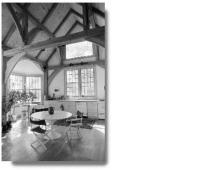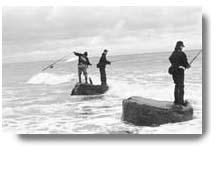Pieces Of Pollock In A Puzzle
Pieces Of Pollock In A Puzzle
Critics and art historians have spent years picking apart Jackson Pollock's Abstract Expressionist masterpieces. Now art fans and jigsaw buffs are devoting their time to putting them back together.
Jackson Pollock jigsaw puzzles. The thought is enough to intimidate even the most jaded puzzle pro.
"Autumn Rhythm Number 30" reduced to 500 maddeningly identical puzzle pieces? That's exactly what one can order through the 1996 Christmas catalogues of such prominent art repositories as the Metropolitan Museum and the Smithsonian Institution.
Three Jigsaw Puzzles
Painted in 1950, "Autumn Rhythm Number 30" is the third Pollock work to be licensed by the Pollock-Krasner Foundation for reprint as a jigsaw puzzle. It joins the 1952 painting "Convergence," published by Battle Road Press in New Hampshire, and the Guggenheim Museum's "puzzle-in-a-can" version of "Alchemy" (1947).
The Guggenheim, incidentally, has also worked its "Alchemy" on a scarf, diary, baseball, and "note cube."
With their layers upon layers of dripped paint and chaotic color fields stretching from one end of the canvas to the other, Pollock's paintings would certainly present a challenge to reconstruct from a pile of puzzle pieces.
"It's challenging, all right," said Helen Harrison, the director of the Pollock-Krasner House and Study Center. "A girlfriend of mine was given ["Convergence"] by a friend who wanted to twist the knife a bit."
Her friend "agonized over it for days," said Ms. Harrison.
The Study Center sells copies of the "Convergence" puzzle, along with a small collection of other Pollock merchandise, in a gift shop it set up this year.
The center does not own any of Pollock's paintings nor any licensing rights to them - that is done through the Pollock-Krasner Foundation, which was established by the artist's wife, the painter Lee Krasner, in her will.
The Floor Store
The center does, however, own Pollock's studio, with its paint-dribbled floorboards carrying the legacy of the master. Some people regard the floor as a work of art in itself.
Hence, "The Floor Store." That's how Ms. Harrison refers to the center's new museum shop.
First, there's the solar-powered T-shirt. The shirt, made by a company called SunWorks, depicts the studio floorboards in somewhat drab tones. But once activated by sunlight or any ultraviolet source, the colors jump to life and glow off the shirts.
Then there's the studio-floor computer mouse pad. The mouse pad was the Study Center's own idea.
"Your mouse can run all over the Pollock-Krasner floor without damaging anything!" Ms. Harrison said with sales-pitch inflections. The mouse pads are produced by Town and Country Photo in East Hampton.
The studio floor is also seen in the cover design of a compact disc the Study Center sells, featuring interviews with Jackson Pollock and Lee Krasner.
But do posthumous Pollock puzzles, solar-powered T-Shirts, and "Alchemy" baseballs trivialize the artwork?
Trivialization?
"I'm somewhat ambivalent about it," said Ms. Harrison. "It depends on the product."
"The floor? No problem. A floor's a floor. But when you're talking about a work of art, it's different."
"Of course, once you complete 'Convergence' you have a beautiful piece of art. Doing the puzzle also makes you look at the painting in a very intense way, and that I don't think is trivializing it. The note cube? That's a toughie."
Museum merchandise and fine-art reproductions are, of course, big business, and the modest "Floor Store" has been catching on fast. The Study Center sells its items - which also include books and postcards - by mail order as well as on-site.
"We even got an order from someone in Bosnia," Ms. Harrison marveled.
The Pollock-Krasner House and Study Center is quartered in the former home of the two artists, at 830 Springs-Fireplace Road in Springs.


